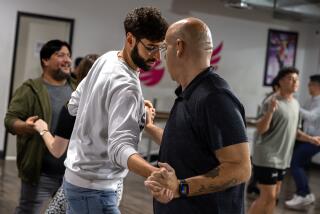A lot harder than it looks
- Share via
After launching himself as a choreographic chameleon, former Paul Taylor principal David Parsons has arrived at a style fusing the strong sense of structure evident in his earlier works with a deceptively spontaneous, flyaway attack. The result is dancing that initially looks as if it’s being made up on the spot but that on closer inspection reveals technical smarts galore.
At the Cerritos Center on Tuesday, the 11-dancer Parsons Company shared the evening with the Ahn Trio, Korean-born masters of sizzling, perfectly focused musicianship. An overload of music by Kenji Bunch made the last half of the program seem repetitive and overlong. However, the performances remained faultless and the lighting by Howell Binkley typically exemplary. Only the Cerritos sound system proved unreliable.
Set to music by the Turtle Island String Quartet, Parsons’ handsome and exciting “Rise and Fall” used the phenomenally gifted Katarzyna Skarpetowska to initiate and provide counterpoint for the actions of six others -- everyone dressed in Steven Cuba arrangements of crushed velvet over black net. Loose and flung out, with sprawling collapses and limp reclining poses reiterated as motifs, the choreography kept Skarpetowska always out of touch with the group members’ energies and always reaching for something that they couldn’t provide.
“Slow Dance” (to Bunch’s music) placed the musicians on the right of the stage; six dancers clustered tightly nearby, alternating between smooth, formal slow-motion lifts and sudden spasms of convulsive torso shudders. As the music heated up, the slowness and formality yielded to hectic, nearly desperate changes of partners, flashy interludes (a male duet, a woman’s trio) and increasingly wild gesticulation.
Elegantly costumed by A. Christina Giannini, “Swing Shift” deployed the statuesque Elizabeth Koeppen in key solos but was soon dominated by the virtuosic partnership of Skarpetowska and Brian McGinnis, the most prominent of three alternating couples. Parsons layered duets and trios with great assurance here and managed to make the high-Romantic fervor of the dancing suit the jazzy propulsion of Bunch’s score -- until things doubled back once or twice too often and the piece became predictable.
Most choreographers of his generation ignore pantomime entirely, but Parsons seems fascinated with its technical possibilites, developing it not merely as an expressive language (the traditional usage) but, in Koeppen’s passages, as a form of concentrated, high-speed rhythmic display. He also likes to undermine conventional dance symmetries, adding a female onlooker to what would ordinarily be an energetic women’s duet in “Rise and Fall,” for instance, so that the onlooker’s stillness becomes a kind of questioning element in the choreography. Such moments deliver an impressive quota of bravura modern dance but also reveal Parsons’ conceptual sophistication and his need to keep looking for new ways into the music, the vocabulary and the idea of performance itself.
Parsons’ familiar signature solo “Caught” found the tireless Sumayah McRae seeming to hover in the air, lighted by strobe flashes that invoked the same perceptual anomaly -- persistence of vision -- that makes us see rapidly changing still photos as a moving picture. Other interpreters have found more drama in the extreme physical contrasts of the work, but McRae delivered its showpiece components superbly.
Besides accompanying the dancing, Angela, Maria and Lucia Ahn began the evening with accomplished performances of Michael Nyman’s “Yellow Beach,” Ronn Yedidia’s “Lullabye” and Astor Piazzolla’s tango “Primavera Portena.”
More to Read
The biggest entertainment stories
Get our big stories about Hollywood, film, television, music, arts, culture and more right in your inbox as soon as they publish.
You may occasionally receive promotional content from the Los Angeles Times.










